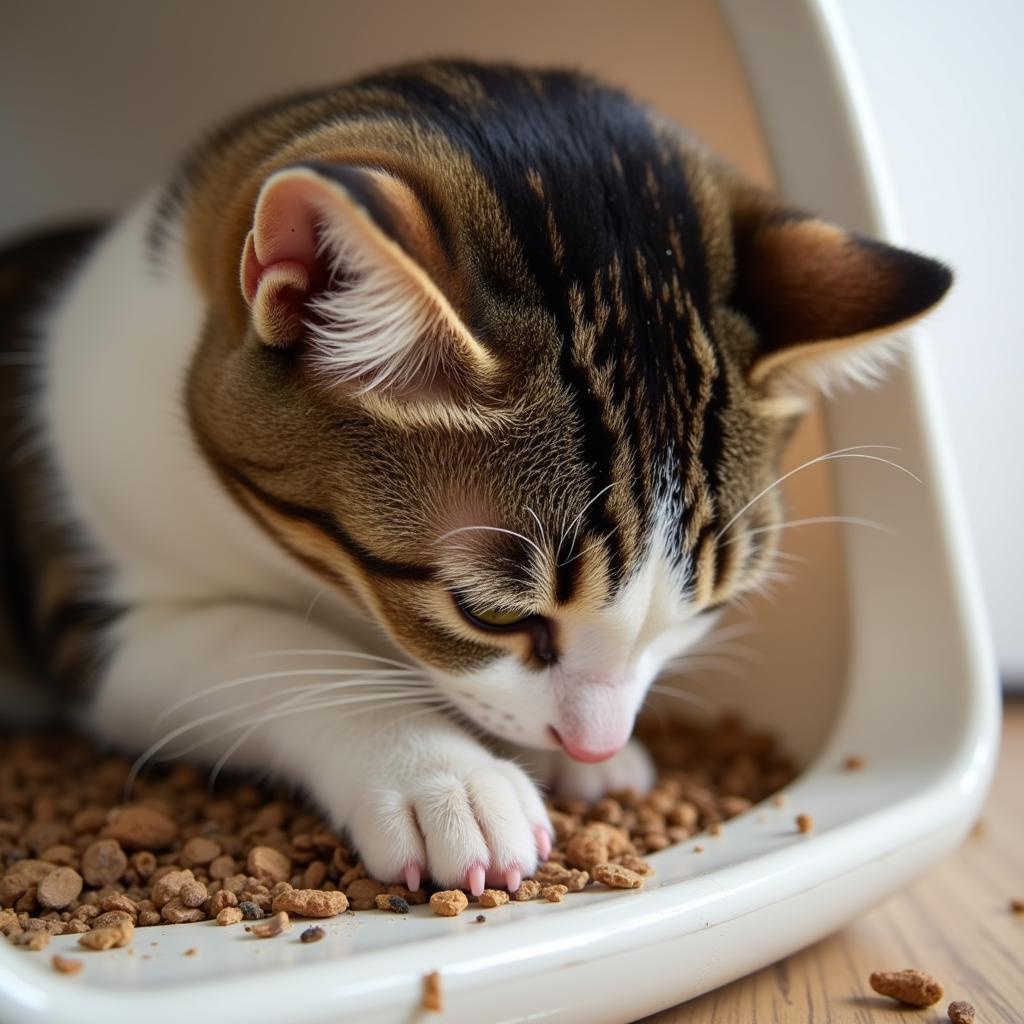Imagine finding tiny bugs jumping around your cat’s litter box – not a pleasant sight, right? These unwelcome visitors are more than just a nuisance; they can potentially harm your cat and even spread to other areas of your home.
Let’s explore the common culprits behind this jumping bug infestation in cat litter, discuss effective ways to eliminate them, and provide preventative measures to keep your cat’s litter box, and your home, bug-free.
Identifying the Jumping Culprits: Who’s Lurking in Your Cat’s Litter Box?
Before declaring war on these jumping bugs, it’s crucial to identify them correctly. This will help you determine the most effective extermination method. Here are some common suspects:
1. Flea Infestation
Fleas, notorious for their jumping abilities, are often the prime suspects. These tiny, dark-brown insects thrive in warm, humid environments, making cat litter boxes an ideal breeding ground.
How to Identify:
- Visual Inspection: Carefully examine your cat’s fur for small, dark bugs that jump when disturbed. You might also spot flea dirt, which resembles tiny black pepper flakes, on their skin or in the litter.
- Flea Comb: Use a fine-toothed flea comb to comb through your cat’s fur, looking for fleas or flea dirt.
2. Other Tiny Insects
While fleas are the usual suspects, other insects might also be responsible for the jumping spectacle in your cat’s litter box. These include:
- Springtails: These tiny, wingless insects are known for their ability to jump significant distances. They are attracted to moisture and decaying organic matter, making a less-than-clean litter box a potential haven.
- Mites: Certain types of mites, though very small, can appear as jumping bugs to the naked eye. They thrive in damp, warm conditions and can cause skin irritation in cats.
Causes of Jumping Bugs in Cat Litter
Several factors contribute to these pesky insects finding their way into your cat’s litter box:
- Unsanitary Litter Box Conditions: Infrequent scooping and cleaning create a haven for insects.
- Warm and Humid Environment: Fleas, springtails, and mites thrive in environments with high humidity and warm temperatures.
- Outdoor Access: Cats with access to the outdoors are more likely to pick up fleas and other bugs.
 Cat scratching in a litter box
Cat scratching in a litter box
Eliminating Jumping Bugs from Cat Litter
Discovering these jumping bugs can be unsettling, but don’t fret! Here’s a comprehensive plan to reclaim your cat’s litter box:
1. Thorough Litter Box Cleaning:
- Empty the Litter Box: Discard all the litter, preferably in a sealed bag to prevent further infestation.
- Wash and Disinfect: Thoroughly wash the litter box with hot, soapy water and disinfect it with a pet-safe disinfectant.
- Dry Completely: Allow the litter box to dry completely before adding fresh litter.
2. Treat Your Cat:
- Consult Your Veterinarian: Seek professional advice on the most suitable flea and tick treatment for your cat, considering their age, health, and lifestyle.
- Flea Combs: Regularly comb your cat’s fur with a flea comb to remove any remaining fleas or eggs.
3. Address the Environment:
- Vacuum Regularly: Vacuum your home thoroughly, paying attention to areas where your cat frequents. Empty the vacuum cleaner bag immediately to prevent fleas from escaping.
- Wash Bedding: Wash your cat’s bedding, blankets, and any other washable items they come into contact with in hot water and dry them on high heat.
- Consider Insecticides: If the infestation is severe, you may consider using insecticides specifically designed for fleas or other identified insects. Consult with a pest control professional to ensure safe and effective application.
Preventing Future Infestations
Prevention is key to maintaining a bug-free environment for you and your feline companion. Here are some proactive measures:
- Maintain Litter Box Hygiene: Scoop the litter box at least once a day, and perform a complete litter change and box cleaning at least once a week.
- Choose the Right Litter: Opt for low-dust, quick-clumping litter that minimizes the accumulation of moisture and odor.
- Regular Flea and Tick Prevention: Consult your veterinarian about year-round flea and tick prevention medication for your cat.
- Control Humidity Levels: Use dehumidifiers if necessary to reduce moisture levels in your home, making it less appealing to moisture-loving bugs.
FAQs: Common Questions About Jumping Bugs in Cat Litter
1. Can these bugs harm my cat?
Yes, fleas and some mites can cause skin irritation, allergic reactions, and even transmit diseases to your cat.
2. Can these bugs infest my home?
Yes, fleas, in particular, can easily infest your home, hiding in carpets, furniture, and bedding.
3. What if the infestation persists after cleaning?
If you’ve tried the above steps and the infestation persists, it’s best to consult a pest control professional for comprehensive treatment.
Seeking Professional Help
Dealing with jumping bugs in your cat’s litter box can be challenging, but it’s essential to address the issue promptly to protect the health and well-being of both your feline companion and your family.
For persistent infestations or if you have any concerns, don’t hesitate to contact a veterinarian or pest control professional for expert guidance and assistance. Remember, a clean and healthy environment contributes to a happy and thriving cat!
For further assistance, please contact us at Phone Number: 0902476650, Email: [email protected] or visit us at 139 Đ. Võ Văn Kiệt, Hoà Long, Bà Rịa, Bà Rịa – Vũng Tàu, Việt Nam. We have a 24/7 customer support team ready to assist you.





